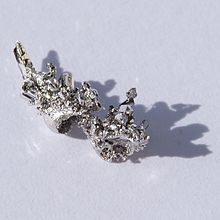Palladium catalyst
 |
|||||||||||||||||||||||||||||||||||||||||||||||||||||
| General properties | |||||||||||||||||||||||||||||||||||||||||||||||||||||
|---|---|---|---|---|---|---|---|---|---|---|---|---|---|---|---|---|---|---|---|---|---|---|---|---|---|---|---|---|---|---|---|---|---|---|---|---|---|---|---|---|---|---|---|---|---|---|---|---|---|---|---|---|---|
| Pronunciation |
/pəˈleɪdiəm/ |
||||||||||||||||||||||||||||||||||||||||||||||||||||
| Appearance | silvery white | ||||||||||||||||||||||||||||||||||||||||||||||||||||
| Standard atomic weight (Ar, standard) | 106.42(1) | ||||||||||||||||||||||||||||||||||||||||||||||||||||
| Palladium in the periodic table | |||||||||||||||||||||||||||||||||||||||||||||||||||||
|
|||||||||||||||||||||||||||||||||||||||||||||||||||||
| Atomic number (Z) | 46 | ||||||||||||||||||||||||||||||||||||||||||||||||||||
| Group | group 10 | ||||||||||||||||||||||||||||||||||||||||||||||||||||
| Period | period 5 | ||||||||||||||||||||||||||||||||||||||||||||||||||||
| Element category | transition metal | ||||||||||||||||||||||||||||||||||||||||||||||||||||
| Block | d-block | ||||||||||||||||||||||||||||||||||||||||||||||||||||
| Electron configuration | [Kr] 4d10 | ||||||||||||||||||||||||||||||||||||||||||||||||||||
|
Electrons per shell
|
2, 8, 18, 18 | ||||||||||||||||||||||||||||||||||||||||||||||||||||
| Physical properties | |||||||||||||||||||||||||||||||||||||||||||||||||||||
| Phase at STP | solid | ||||||||||||||||||||||||||||||||||||||||||||||||||||
| Melting point | 1828.05 K (1554.9 °C, 2830.82 °F) | ||||||||||||||||||||||||||||||||||||||||||||||||||||
| Boiling point | 3236 K (2963 °C, 5365 °F) | ||||||||||||||||||||||||||||||||||||||||||||||||||||
| Density (near r.t.) | 12.023 g/cm3 | ||||||||||||||||||||||||||||||||||||||||||||||||||||
| when liquid (at m.p.) | 10.38 g/cm3 | ||||||||||||||||||||||||||||||||||||||||||||||||||||
| Heat of fusion | 16.74 kJ/mol | ||||||||||||||||||||||||||||||||||||||||||||||||||||
| Heat of vaporization | 358 kJ/mol | ||||||||||||||||||||||||||||||||||||||||||||||||||||
| Molar heat capacity | 25.98 J/(mol·K) | ||||||||||||||||||||||||||||||||||||||||||||||||||||
Vapor pressure
|
|||||||||||||||||||||||||||||||||||||||||||||||||||||
| Atomic properties | |||||||||||||||||||||||||||||||||||||||||||||||||||||
| Oxidation states | 0, +1, +2, +3, +4 |
||||||||||||||||||||||||||||||||||||||||||||||||||||
| Electronegativity | Pauling scale: 2.20 | ||||||||||||||||||||||||||||||||||||||||||||||||||||
| Ionization energies |
|
||||||||||||||||||||||||||||||||||||||||||||||||||||
| Atomic radius | empirical: 137 pm | ||||||||||||||||||||||||||||||||||||||||||||||||||||
| Covalent radius | 139±6 pm | ||||||||||||||||||||||||||||||||||||||||||||||||||||
| Van der Waals radius | 163 pm | ||||||||||||||||||||||||||||||||||||||||||||||||||||
|
|||||||||||||||||||||||||||||||||||||||||||||||||||||
| Miscellanea | |||||||||||||||||||||||||||||||||||||||||||||||||||||
| Crystal structure | face-centered cubic (fcc) | ||||||||||||||||||||||||||||||||||||||||||||||||||||
| Speed of sound thin rod | 3070 m/s (at 20 °C) | ||||||||||||||||||||||||||||||||||||||||||||||||||||
| Thermal expansion | 11.8 µm/(m·K) (at 25 °C) | ||||||||||||||||||||||||||||||||||||||||||||||||||||
| Thermal conductivity | 71.8 W/(m·K) | ||||||||||||||||||||||||||||||||||||||||||||||||||||
| Electrical resistivity | 105.4 nΩ·m (at 20 °C) | ||||||||||||||||||||||||||||||||||||||||||||||||||||
| Magnetic ordering | paramagnetic | ||||||||||||||||||||||||||||||||||||||||||||||||||||
| Magnetic susceptibility | +567.4·10−6 cm3/mol (288 K) | ||||||||||||||||||||||||||||||||||||||||||||||||||||
| Young's modulus | 121 GPa | ||||||||||||||||||||||||||||||||||||||||||||||||||||
| Shear modulus | 44 GPa | ||||||||||||||||||||||||||||||||||||||||||||||||||||
| Bulk modulus | 180 GPa | ||||||||||||||||||||||||||||||||||||||||||||||||||||
| Poisson ratio | 0.39 | ||||||||||||||||||||||||||||||||||||||||||||||||||||
| Mohs hardness | 4.75 | ||||||||||||||||||||||||||||||||||||||||||||||||||||
| Vickers hardness | 400–600 MPa | ||||||||||||||||||||||||||||||||||||||||||||||||||||
| Brinell hardness | 320–610 MPa | ||||||||||||||||||||||||||||||||||||||||||||||||||||
| CAS Number | 7440-05-3 | ||||||||||||||||||||||||||||||||||||||||||||||||||||
| History | |||||||||||||||||||||||||||||||||||||||||||||||||||||
| Naming | after asteroid Pallas, itself named after Pallas Athena | ||||||||||||||||||||||||||||||||||||||||||||||||||||
| Discovery and first isolation | William Hyde Wollaston (1802) | ||||||||||||||||||||||||||||||||||||||||||||||||||||
| Main isotopes of palladium | |||||||||||||||||||||||||||||||||||||||||||||||||||||
|
|||||||||||||||||||||||||||||||||||||||||||||||||||||
Palladium is a chemical element with symbol Pd and atomic number 46. It is a rare and lustrous silvery-white metal discovered in 1803 by William Hyde Wollaston. He named it after the asteroid Pallas, which was itself named after the epithet of the Greek goddess Athena, acquired by her when she slew Pallas. Palladium, platinum, rhodium, ruthenium, iridium and osmium form a group of elements referred to as the platinum group metals (PGMs). These have similar chemical properties, but palladium has the lowest melting point and is the least dense of them.
More than half the supply of palladium and its congener platinum is used in catalytic converters, which convert as much as 90% of the harmful gases in automobile exhaust (hydrocarbons, carbon monoxide, and nitrogen dioxide) into less noxious substances (nitrogen, carbon dioxide and water vapor). Palladium is also used in electronics, dentistry, medicine, hydrogen purification, chemical applications, groundwater treatment, and jewelry. Palladium is a key component of fuel cells, which react hydrogen with oxygen to produce electricity, heat, and water.
Ore deposits of palladium and other PGMs are rare. The most extensive deposits have been found in the norite belt of the Bushveld Igneous Complex covering the Transvaal Basin in South Africa; the Stillwater Complex in Montana, United States; the Sudbury Basin and Thunder Bay District of Ontario, Canada; and the Norilsk Complex in Russia. Recycling is also a source, mostly from scrapped catalytic converters. The numerous applications and limited supply sources result in considerable investment interest.
...
Wikipedia


